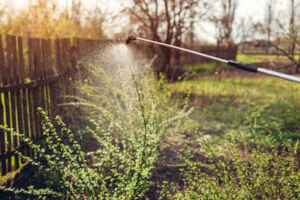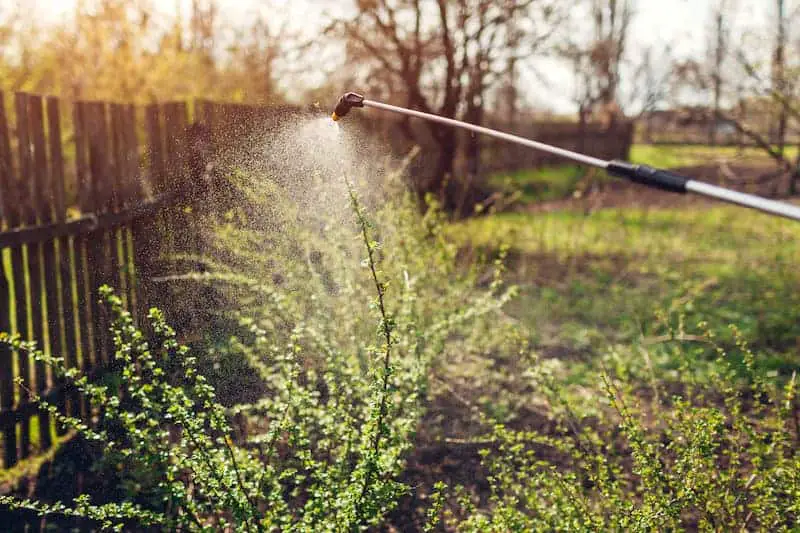What You Should Know About Edge Pest Control
Almost every homeowner struggles with some type of yard or lawn pest. Thankfully, there are many types of pest control and methods to effectively address your unique pest issues. One such method is edge pest control.
What is edge pest control? Edge pest control is a term used when referring to pest extermination in an area where two different types of environments meet. For example, if your backyard meets the forest, then that line between the backyard and the forest is an edge zone. Edge pest control is very important because this zone provides pests with greater opportunities for access to human habitats.
Keep reading to learn more about edge pest control and other pest control methods for your outdoor living spaces.
What Are the Most Common Forms of Edge Pest Control?
 The most common form of edge pest control is using insecticidal soap to kill off larvae present on plant leaves.
The most common form of edge pest control is using insecticidal soap to kill off larvae present on plant leaves.
Another form would be using neem oil on lawns to eliminate many different types of insects including spider mites and aphids. It is important that you read all instructions carefully before applying any chemicals near the edges.
There are no set guidelines when it comes to edge pest control in lawns. Many homeowners use a combination of cultural and chemical methods to keep their grass free of pests.
The landscape around an agricultural field can be a significant source of pest insects and mites. These pests include various species of crop-damaging moths, ticks, beetles, and thrips; aphids and whitefly that vector plant viruses; and spider mites (Tetranychidae) and eriophyid mites that feed on leaves.
Although these pests can be sufficiently controlled by pesticides applied to the crop itself, managing them in the peripheral landscape is often desirable.
Edge habitat management has been used to provide a refuge for natural enemies of agricultural pests. The term “edge” refers to borders formed by woodland, scrubland, or other non-crop vegetation near farmland. One important form of edge habitat is the shelterbelt, a group of trees or shrubs planted to protect an agricultural area from wind.
Which Pest Control Method Should You Use?
The most common pest control methods used are mostly mechanical, such as barriers or traps. Chemical methods of extermination are sometimes not practical for this area because it has a higher chance of affecting non-targeted species, which may be beneficial to the surrounding environment.
Nevertheless, trapping pests in edge areas is effective. This is because certain types of predators are able to prey on the pests in these habitats. Chemical pesticides, on the other hand, kill indiscriminately, whether be it a predator or a pest’s natural food source.
How Each Pest Control Method Works
- Pests usually search for an environment that provides them with ample food sources and shelter. This is why edge areas are great locations for pest infestation.
- Barriers and traps work better than chemical agents. This is because certain types of predators prey on the pests in these habitats. This is not true for chemicals that kill indiscriminately, whether it be a predator or its food source.
- Traps are effective as they can be part of an ongoing pest control program to monitor pest populations and establish new control methods.
- Biological control is one way of dealing with pests in this area, as well as mechanical and chemical agents. Chemical agents are not typically used because they pose a great risk to non-targeted species.
There are many ways to deal with pests in this area, including biological control measures, mechanical and chemical agents. Chemical agents are not typically used because they pose a great risk to non-targeted species.
Traps also work better than chemical pesticides. Traps can be part of an ongoing pest control program that monitors the population and establishes new control methods. Biological control is one way of dealing with pests in these areas. It also includes mechanical and chemical agents.
Mechanical methods are usually more effective than chemicals, as they can effectively manage pests without posing risk to non-targeted species. Barrier methods work better than chemicals because certain types of predators prey on the pests in these habitats.
Importance of Edge Pest Control
 Every gardener knows that controlling pests in the garden is an essential part of growing vegetables. However, what many do not consider is how to control pests on the edges between your property and the open ground nearby that may be attractive to pests looking for food.
Every gardener knows that controlling pests in the garden is an essential part of growing vegetables. However, what many do not consider is how to control pests on the edges between your property and the open ground nearby that may be attractive to pests looking for food.
Whether you are trying to grow crops or keep a beautiful lawn free of weeds, these borders need to be free of pests, too. Here are some ways to control garden pests on the edges between your property and the open ground near it.
According to the University of California Integrated Pest Management program, over 700 species of insects live naturally in California alone, so controlling these pests can seem daunting. However, with patience and persistence, you can overcome any edge pest control problems you may encounter.
Using cultural methods such as rotating crops and practicing proper sanitation can reduce the number of pests in your garden dramatically. Sanitation is especially important when it comes to edge pest control.
If there are any diseased or rotting plants or vegetables near the edge, they will attract pests that will then come into your garden. Some common crops that are particularly susceptible to pest damage near the edges of your property are potatoes, petunias, tomatoes, peppers, beans, eggplants, and strawberries.
Chemical controls are not recommended in most cases when it comes to edge pest control because they will kill beneficial insects as well as the target pests. Insecticidal soap can be used with some success, but only on the leaves of plants and very young pests.
If you must use a chemical treatment, try using neem oil to kill many different types of insects including spider mites and aphids. It is important that you read all instructions carefully before applying any chemicals near the edges.
When You Should Call Pest Control
It may be time to call in a professional if you have tried both cultural and chemical treatments and still cannot control pests in your garden.
The main reason people call in pest control is that there is some type of infestation happening. The most common types of pests are insects. Although rodents, mold, and other plant diseases are also controlled by pest control services. This would be the only reason that people call in pest control, but there is actually more than just this.
Chemical Pest Control Treatments
 There are no set guidelines when it comes to edge pest control in lawns. Many homeowners use a combination of cultural and chemical methods to keep their grass free of weeds and other pests.
There are no set guidelines when it comes to edge pest control in lawns. Many homeowners use a combination of cultural and chemical methods to keep their grass free of weeds and other pests.
One common method is treating the edge between your property and open ground with a strip of white vinegar or boiling water.
This will kill anything in its path but will not affect the grass. If you choose to use a chemical treatment, make sure it is specifically labeled for lawns.
Pest control in the edge areas of your property should take into account any other vegetation that may be present there. In some cases, this can mean letting certain problem weeds exist while eliminating others because they are growing along the edge. If you have any questions about which plants or flowers to leave and which to remove, consult your local extension service.
Cultural Pest Control Treatments
Many pests such as grasshoppers and crickets like to eat tender annuals such as petunias, tomatoes, and peppers. This is because they are high in nitrogen. One way to reduce the number of these edge pests is by using floating row covers over top of your annuals. These are lightweight, translucent covers that will keep pests off your plants while allowing sunlight and rain to pass through.
If you would like more information on how to find them or use them, consult with your local extermination service. By making use of cultural methods such as crop rotation and practicing good sanitation practices, you can often rid your garden edge of many pests that might otherwise be attracted to it.
In addition, there are some chemical treatments as well as homemade fixes such as vinegar and boiling water that may come in handy. However, if these methods fail to eliminate the problem you will need to call in a professional for further assistance.
How is An Edge Different From Other Areas?
An edge is an area where two things meet. Often this will be where two types of land come together such as a meadow and a forest. Many homes and businesses don’t run into this issue, so it isn’t commonly thought of. However, if you have a property that is backed up by a creek or forest, taking proper care of that is so important.
Final Thoughts
In conclusion, there are several different types of pest control methods that can be used to eliminate the pests living in the edge zone. These methods vary in terms of effectiveness and how they affect the surrounding environment. Mechanical control, such as traps and barriers, is a better option than using chemical agents because they affect only the targeted species without affecting other organisms that may contribute to the surrounding ecosystem. Lastly, biological control is another method that can be applied when dealing with these kinds of pests.

